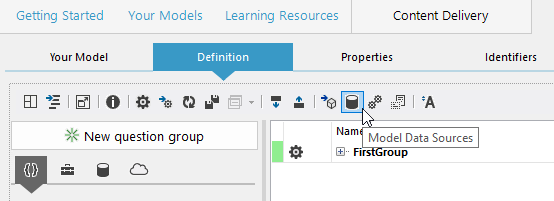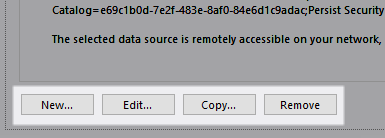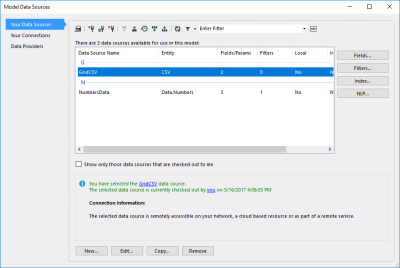A KnowledgeKube data source is a set of instructions that lets one or more models consume the data supplied by a data connection. Each data source determines the table to be interrogated, and which of that table's fields will be returned. Each connection can be used to create as many data sources as a model needs.
The act of exchanging data via a connection is known as a Transaction. The duration of a transaction is known as the Scope. For more information, refer to Appendix: Data Source Transaction Scoping.
To view a list of data sources available to a specific model, switch to the model's Definition tab and click ![]() in its toolbar.
in its toolbar.

Accessing the current model's data sources via the Definition tab toolbar.
This will open the Model Data Sources interface, which displays the Your Data Sources panel by default.
New models begin with no data sources.
To filter the contents of the panel, type a full or partial data source name into the Filter field and press Return. Any data source whose name does not contain the specified text string will be hidden. You can remove the current filter by clearing the field and pressing Return once more.

Filtering the list of data sources.
Selecting a data source from the list will display relevant information near the bottom of the panel.

Information about the currently selected data source.
You can make changes to the list using the window's toolbar.

The Your Data Sources toolbar, with buttons for adding, editing and removing highlighted.
Like many types of content, you can only make changes to a data source if you have it Checked Out. By default, new data sources are automatically checked out to the person who created them. To hide all data sources not currently checked out to you, select the check box below the main list. This is particularly useful if you are working with other users on a model that has a lot of data sources.
The buttons in the panel's toolbar are as follows:
| Icon | Description | Further Reading |
|---|---|---|
|
|
Switches to the Your Connections panel, which lets you view, create, and edit data connections in the current repository. | Data Connections |
|
|
Begins the creation of a data source. There are four types of data source: Standard, T-SQL, and Stored Procedure, with the creation of each type described in its own individual topic. | Creating a Standard Data Source / Creating a T-SQL Data Source / Configuring a Stored Procedure |
|
|
Opens a window that lets you edit the selected data source. The window is near-identical to the one used to create data sources. This option is only available if the data source is checked out to you. | Editing a Data Source's Properties |
|
|
Permanently deletes the selected data source, including any associated filters. This option is only available if the data source is checked out to you. You will be asked to confirm the deletion. | Deleting a Data Source |
|
|
Checks the selected data source out to you. This button will not be available if the data source is already checked out. | Source Control |
|
|
Checks the selected data source back in. You will be asked to provide a check in comment - and, optionally, a check-in reference - before clicking Check In. This button will only be available if you have the selected data source checked out. | Source Control |
|
|
Opens the History window for the selected data source, letting you view a full list of check-in entries for the data source, including who checked it in, when the check-in took place, and the comments and reference provided during check-in. This window is for information only, and pressing OK will close it. |
|
|
|
Checks out all available data sources to you, assuming they are not already checked out. | Source Control |
|
|
Simultaneously checks in all data sources that are currently checked out to you. Similar to checking in a single item, you will be asked to provide a check-in comment and, optionally, a reference. | Source Control |

|
Refreshes the list of data sources to reflect recent updates made by other users. | |

|
Chooses one type of data source to display, making it easier to locate specific data sources. |
The four buttons at the bottom of the window let you add, edit, and remove data sources in the same manner described above. There is also a Copy button here, which lets you create a duplicate of the selected data source.

Use these buttons to add and modify your application's data sources.

